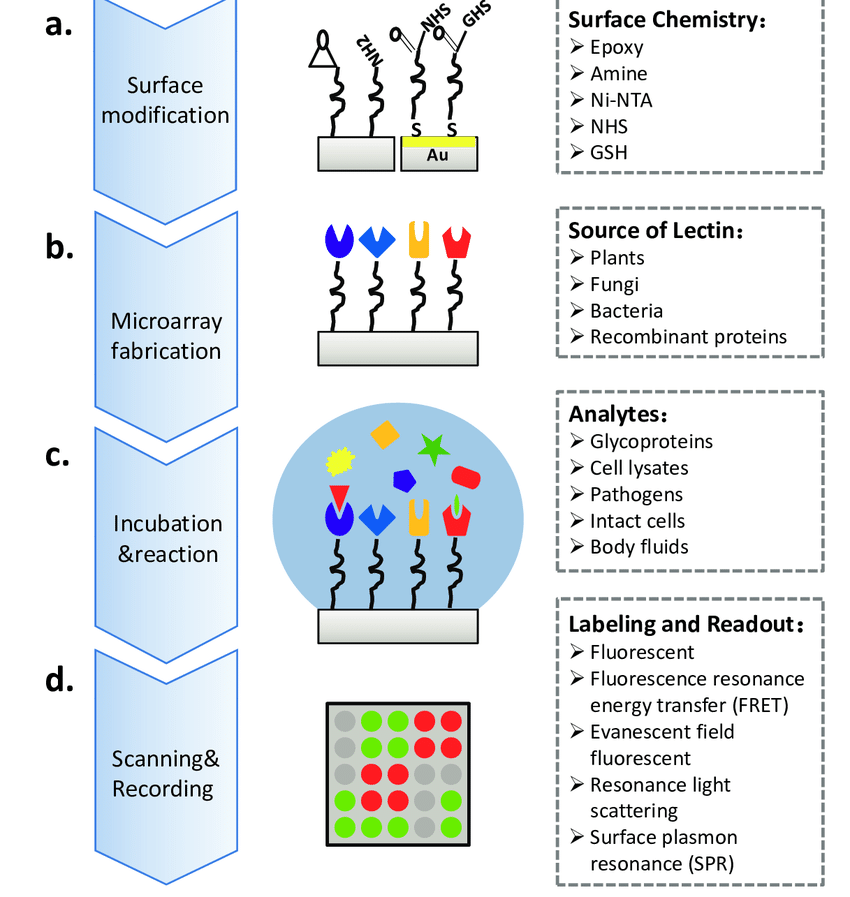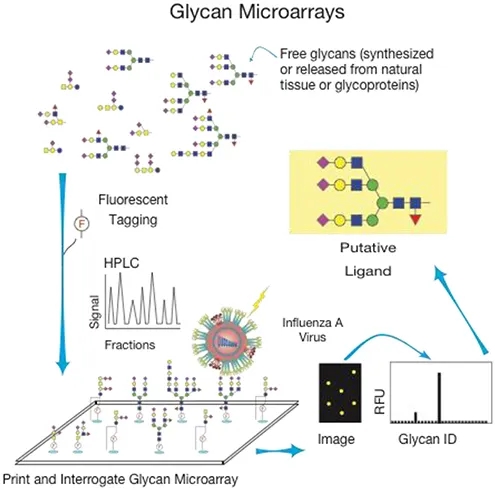Glycobiology Microarray Service
Glycobiology Microarray Service is a glycobiology research solution based on microarray technology. It involves immobilizing various carbohydrate molecules (including glycans, glycopeptides, glycoproteins, and glycosphingolipids) or their recognition partners (such as lectins and enzymes) onto a solid-phase support, enabling high-throughput detection and systematic analysis of glycan-molecule interactions.
As a vital branch of life sciences, glycobiology not only focuses on the structural characteristics of carbohydrates themselves but also investigates their interactions with biomacromolecules such as proteins, lipids, and nucleic acids, as well as their functional mechanisms in health and disease.
A microarray refers to a high-throughput analytical technology in which a large number of known molecules (DNA, proteins, glycans, etc.) are immobilized on a solid substrate in a high-density, orderly arrangement. By specifically binding to target molecules and detecting the resulting signals, it enables the simultaneous analysis of hundreds to thousands of interaction events.
Using microarray technology, a glycobiology microarray can be constructed by immobilizing diverse glycans or other known molecules on the surface of a chip, which can be applied to detect interactions between glycans and proteins, antibodies, cells, or pathogens.
Services at MtoZ Biolabs
Leveraging an advanced glycomics analysis platform and well-established microarray fabrication technology, MtoZ Biolabs offers Glycobiology Microarray Service covering a wide range of biological systems and research areas. This service enables researchers to efficiently analyze glycan–molecule interactions, identify disease-associated glycan biomarkers, and evaluate the performance of glyco-engineered products.
Heparin Sulfate Microarray Service
Immobilizes heparin sulfate oligomers or polymers with different sulfation patterns and degrees of polymerization onto a solid phase support for systematic analysis of their binding properties with proteins, cytokines, and pathogens.
Uses lectin arrays to achieve high-throughput identification and comparison of glycan profiles in samples.

Zhou SM. et al. Comb Chem High Throughput Screen. 2011.
Figure 1. The Procedure for A Typical Lectin Microarray Experiment.
Glycosphingolipid Microarray Service
Analyzes the mechanisms of glycosphingolipids in cell recognition, signal transduction, and pathogen invasion using glycosphingolipid microarrays.
Glycosaminoglycan Microarray Service
Studies the interaction network between glycosaminoglycans and proteins, viruses, and cytokines using glycosaminoglycan microarrays.
Glycoprotein Microarray Service
Immobilizes glycoproteins onto a solid support surface to construct microarrays, assessing glycosylation patterns and their binding properties with receptors and antibodies.
Glycopeptide Microarray Service
Fixes glycopeptides with specific glycosylation modifications onto a solid support and analyzes their functional roles in immune responses, molecular recognition, and vaccine design through specific binding reactions with target molecules.
Pathogen-Associated Glycan Microarray Service
Uses glycan microarrays to react with pathogens or their glycan-binding proteins, elucidating host-pathogen interaction mechanisms and identifying potential glycosylation biomarkers and targeted intervention pathways.
Detects the specificity and affinity of antibodies toward different glycan antigens.
Enzyme-Glycan Microarray Service
Evaluates the binding patterns and catalytic properties of enzymes with different glycans.
Glycoengineering Microarray Service
Immobilizes engineered cells, glycoproteins, or glycan products onto a chip surface, combining them with labeled lectins, antibodies, or receptor proteins for recognition detection. This service systematically assesses the impact of glycoengineering strategies on glycan expression profiles and their molecular recognition characteristics.
Human Milk Oligosaccharide Microarray Service
Systematically analyzes the binding properties of human milk oligosaccharides with biomolecules (such as bacteria, immune molecules, and receptor proteins) to reveal their mechanisms in immune regulation and anti-infection processes.
Conducts large-scale analysis of interactions between glycan molecules and biological molecules such as antibodies, glycan-binding proteins, cytokines, and pathogens, to efficiently screen glycan-target molecule binding specificity and affinity.

McQuillan AM. et al. Front Mol Biosci. 2019.
Figure 2. General Method for Creation and Use of Glycan Microarrays from Natural Materials.
Microbial Glycan Microarray Service
Performs high-throughput analysis of the binding specificity and affinity between various microbial-derived glycans and host molecules, systematically revealing their functional roles in host-pathogen interactions, immune recognition, and antigen screening.
Service Advantages
Multi-Type Array Coverage: Includes a wide range of microarray services covering glycoproteins, glycopeptides, glycosaminoglycans, glycosphingolipids, pathogen-associated glycans, and more.
High Throughput and High Sensitivity: Capable of simultaneously detecting hundreds to thousands of glycan–molecule interactions, quickly obtaining comprehensive data.
Accurate Quantification and Structural Analysis: Combines fluorescence detection with high-resolution data analysis to precisely determine binding specificity and affinity.
Flexible Customization: Arrays and detection conditions are designed according to research goals, adaptable to various academic and industrial needs.
Experienced Technical Team: Supported by a team of glycobiology and microarray analysis experts, ensuring the scientific rigor and reproducibility of experimental data.
Sample Submission Suggestions
Sample Types
MtoZ Biolabs accepts a variety of sample types, including serum, plasma, cell lysates, purified antibodies, receptors, and more.
Storage and Transportation
Samples should be stored at low temperatures (≤ -20°C) and transported on dry ice. Avoid repeated freeze-thaw cycles.
It is recommended to consult with the MtoZ Biolabs technical team prior to sample submission to discuss experimental objectives and sample characteristics, and to receive detailed and tailored sample preparation and submission guidelines.
Applications
Examples of applications for Glycobiology Microarray Service:
Glycan and Biomolecule Interaction Studies
By systematically analyzing the binding profiles of various glycan molecules with receptors, antibodies, lectins, or signaling molecules, this service reveals glycan binding sites, affinity, and specificity, providing precise data for understanding glycan-mediated signal transduction, immune regulation, and cell-to-cell communication.
Pathogen Recognition and Infection Mechanism Studies
By simulating the host cell surface glycan environment, this service studies the glycan receptor recognition features of pathogens such as viruses, bacteria, and fungi, helping to elucidate the binding patterns and invasion pathways during the infection process, and providing insights for prevention strategies and vaccine design.
Disease-Related Glycosylation Pattern Analysis
By comparing the glycosylation structural changes in healthy and diseased samples, this service identifies potential glycan biomarkers, supporting early disease diagnosis, prognosis assessment, and personalized treatment planning.
Glycan-based Vaccine and Diagnostic Reagent Development
High-throughput screening of glycan structures with high immunogenicity or diagnostic specificity is used for designing and optimizing glycan-based vaccines, antibodies, and molecular probes.
Glycan-binding Protein Specificity and Function Studies
Systematically assesses the recognition abilities of glycan-binding proteins toward different glycan structures, revealing their roles in metabolic regulation, cell signaling, and pathological processes.
Drug Screening and Target Validation
During the drug discovery phase, this service screens candidate molecules for their inhibitory or promoting effects on specific glycan–protein interactions, validating glycan-related disease treatment targets and optimizing lead compound structures.
Glycomics Fundamental Research
Explores the dynamic changes in glycome composition and function under various physiological, developmental, or environmental conditions, laying the foundation for a systematic understanding of the glycobiological network.
MtoZ Biolabs, an integrated chromatography and mass spectrometry (MS) services provider.
Related Services
Glycan Separation and Purification Services
How to order?







